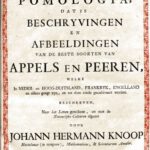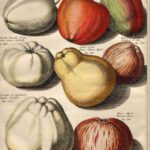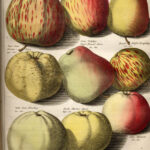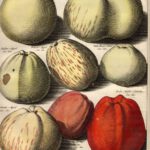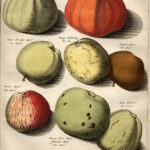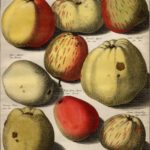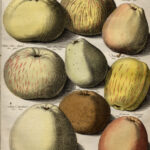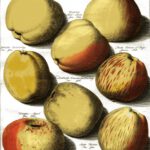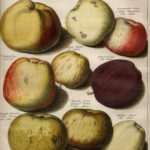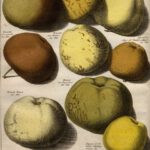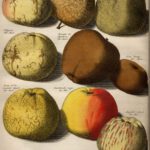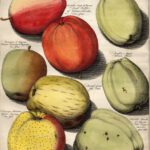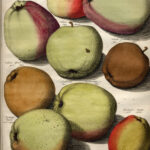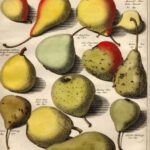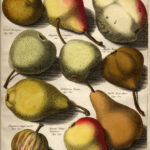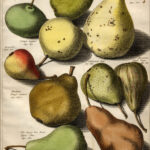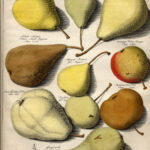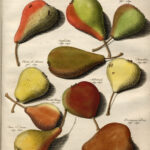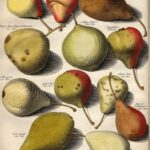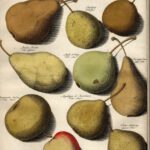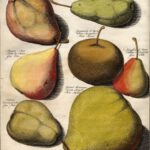Identification
Yet unidentified heirloom fruit is on the one hand being presented to us at identification sessions organized by ourselves, or by others, at which the general public is being offered this service, or is being scouted for by similarly motivated individuals.
Events organized by similarly active organizations at which identification services are being offered may also exist of country fairs, and exhibitions, farmer’s days. Interested individuals also bring in yet unidentified fruit for us to determine the variety name and for maintenance.
About the history of our heirloom fruit: publications and research projects
Where is our real Yellow Transparent apple?
It was just by chance that some time ago now we ran into an article titled EEN NIEUWE APPEL, YELLOW TRANSPARENT (A NEW APPLE, YELLOW TRANSPARENT) published in TIJDSCHRIFT VOOR TUINBOUW No. 1, one of the horticultural journals in The Netherlands at the time, published in 1896 by A. Ide, director at the time of the renowned G.A. van Swieten School of Horticulture.
In this article he describes an attractive American apple cultivar received under the name Yellow Transparent. The apple according to him, had been introduced in The Netherlands by Groenewegen Boomkwekers, a local nurseryman at The Bilt.
Around 1900, another apple, also named Yellow Transparent, syn. Transparente Blanche, Transparent Jaune en White Transparent, appeared in The Netherlands. This apple is locally known as Blanke Madeleine (southwestern province of Zeeland) and St. Jaopik’s apple (eastern province of Gelderland).
In Germany, where this apple is known as Weisser Klarapfel, apparently this apple had been in cultivation ever since the middle of the 19e century. Allegedly, together with similar Russian apples, it had been introduced from one of the Baltic states (Latvia).
When exactly this apple appeared in The Netherlands, is not clear. However, it seems that this apple was sent to the French nurseryman Leroy, at Angers as early as 1852. Allegedly, from France it subsequently was introduced to The Netherlands around 1900, but we have been unable to determine how and by whom.
Never have we encountered or heard of any conflict of naming in nursery lists, nor in the pomological literature, nor through oral history, until by chance, whilst consulting Beach’s standard work, THE APPLES OF NEW YORK (1905), unequaled in the pomological literature, in an attempt to elucidate another identification problem. In fact, in his book he describes an apple by name Yellow Transparent, apparently of the same type and characteristics as described by Ide (see above).
According to Beach, this apple was introduced from Russia by the United States Dept. of Agriculture, in 1970. Immediately, the earlier mentioned article by Ide (1900) came back to my mind. In fact, it became ever so interesting as in this same book another apple, named Thaler, with synonym, also(!), Yellow Transparent, was briefly described by Beach, but considered by him as inferior to the earlier mentioned Yellow Transparent. Thaler, apparently was also known under the synonym Charlottenthaler.
Our particular interest was drawn to the fact that he specifically mentioned the susceptibility of Thaler, apparently als known under the name Chalottenthaler, to fruit tree canker (Nectria galligena), whereas his (American) Yellow Transparent, according to him, was not susceptible to this disease.
Just this particular character of resistance to canker as noticed by Beach that was also explicitly described by Ide. This to us indicates strongly that Ide was indeed dealing with this particular type of Yellow Transparent.
Still we would not have possibly been so strongly interested in this apple, if not for the fact that we had for several years been holding a apple in collection that is nearly identical and in fact very hard to distinguish from our common type of Yellow Transparent, however with one major difference in that it apparently is totally resistant to canker.
Although somehow puzzled by this quality, we had been taking this type for a chance seedling that had emanated from a pip of Yellow Transparent, that had in fact re-appeared in an apparently clonally propagated identity, with one major difference: resistance to canker, possibly derived from an unknown parent. It certainly was the one major reason that we had maintained and even propagated this particular type.
In conclusion: we might be dealing here with the American type of Yellow Transparent that according to Ide (1896) had once been introduced to our country by above-mentioned nurseryman in de early 1890’s
However, as we are not entirely satisfied with this preliminary conclusion, we should be most happy to receive from among the readers of the De Slanke Spil
any further evidence to this effect, in particular as to observed high levels of resistance to canker in the Yellow Transparent tree that one might possibly be having in their orchard or backyard.
Interestingly, and not readily unexplainable to me is the fact that H. de Greeff just a few years thereafter teacher at the same horticultural college as Ide did not refer to the canker resistant American Yellow Transparent in his series of booklets listing apple and pear varieties in ONZE APPELS EN PEREN, published from 1905 through 1908, as the said Yellow Transparent must have been present in this school’s teaching nursery.
Literature:
Ide, A., Een nieuwe appel (Yellow Transparent), (1896), Tijdschrift voor Tuinbouw, No. 1, pg. 14
Beach, S.A. et al., The Apples of New York, volume 1, (1905) Charlottenthaler and Yellow Transparent, pg. 222 and 248, respectively.
De Greeff, H., Onze Appels en Peren (1905- 1908)
(published earlier in De Slanke Spil, Newsletter of Friends of the Fruitteeltmuseum, Kapelle, Zld., The Netherlands, no. 24, maart 2015)
Knoop: Appels
Click on illustration for large view.
- Plaat 100
- Plaat 101
- Plaat 102
- Plaat 103
- Plaat 104
- Plaat 105
- Plaat 106
- Plaat 107
- Plaat 108
- Plaat 109
- Plaat 110
- Plaat 111
- Plaat 112
Knoop: Peren
Click on illustration for large view.
- Plaat I Peer
- Plaat II Peer
- Plaat III Peer
- Plaat IV Peer
- Plaat VI Peer
- Plaat VII Peer
- Plaat VIII Peer
Knoop: Appels
Click on illustration for large view.
- Plaat 100
- Plaat 101
- Plaat 102
- Plaat 103
- Plaat 104
- Plaat 105
- Plaat 106
- Plaat 107
- Plaat 108
- Plaat 109
- Plaat 110
- Plaat 111
- Plaat 112
Knoop: Peren
Klik op illustratie voor grote weergave.
- Plaat I Peer
- Plaat II Peer
- Plaat III Peer
- Plaat IV Peer
- Plaat VI Peer
- Plaat VII Peer
- Plaat VIII Peer
Knoop: Appels
Click on illustration for large view.
- Plaat 100
- Plaat 101
- Plaat 102
- Plaat 103
- Plaat 104
- Plaat 105
- Plaat 106
- Plaat 107
- Plaat 108
- Plaat 109
- Plaat 110
- Plaat 111
- Plaat 112
Knoop: Peren
Click on illustration for large view.
- Plaat I Peer
- Plaat II Peer
- Plaat III Peer
- Plaat IV Peer
- Plaat VI Peer
- Plaat VII Peer
- Plaat VIII Peer
